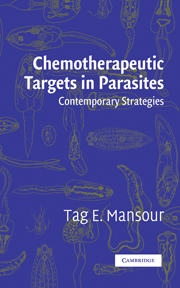Book contents
- Frontmatter
- Contents
- Preface
- Acknowledgments
- 1 The Search for Antiparasitic Agents
- 2 Biophysical, Genomic, and Proteomic Analysis of Drug Targets
- 3 Energy Metabolism in Parasitic Helminths: Targets for Antiparasitic Agents
- 4 Antimalarial Agents and Their Targets
- 5 Antitrypanosomal and Antileishmanial Targets
- 6 Targets in Amitochondrial Protists
- 7 Neuromuscular Structures and Microtubules as Targets
- 8 Targets in the Tegument of Flatworms
- Epilogue
- Index
- References
1 - The Search for Antiparasitic Agents
Published online by Cambridge University Press: 11 August 2009
- Frontmatter
- Contents
- Preface
- Acknowledgments
- 1 The Search for Antiparasitic Agents
- 2 Biophysical, Genomic, and Proteomic Analysis of Drug Targets
- 3 Energy Metabolism in Parasitic Helminths: Targets for Antiparasitic Agents
- 4 Antimalarial Agents and Their Targets
- 5 Antitrypanosomal and Antileishmanial Targets
- 6 Targets in Amitochondrial Protists
- 7 Neuromuscular Structures and Microtubules as Targets
- 8 Targets in the Tegument of Flatworms
- Epilogue
- Index
- References
Summary
Early Beginnings of Chemotherapy
Historical records from almost every culture have examples of successful treatment of different ailments by potions, mainly from vegetable sources and occasionally from animals. A good example of an antiparasitic agent is cinchona bark (quinine), which was used against malaria by the early Peruvians and introduced to the Western World by the Jesuits. Extracts of male fern and of santonin obtained from Artemisia maritima var. anthelmintica were held in high regard as anthelmintics by Theophratus (370–285 b.c.) and Galen (a.d. 130–201) and were also recommended as effective anthelmintics until the 1940s and 1950s (Goodman & Gilman, 1955).
The beginning of chemotherapy as a science had to await the establishment of the germ theory of infection by Louis Pasteur more than a century ago. Rather than accepting the concept of spontaneous generation of infection, Pasteur suggested that diseases are caused by microbes that are transmitted among humans. Pasteur's inspiration for this theory came during his early studies on fermentation for the wine industry in France. Pasteur's contributions influenced bacteriology, immunology, the study of antibiotics, sterilization, epidemiology, and public health. This remarkable era was followed by the discovery and identification of many of the infectious microorganisms and methods for their culture in the laboratory and for infecting experimental animals. The study of parasites was initiated at the time of Sir Patrick Manson (1844–1922), who established the first institute for studying and teaching about tropical diseases: The London School of Hygiene and Tropical Medicine.
- Type
- Chapter
- Information
- Chemotherapeutic Targets in ParasitesContemporary Strategies, pp. 1 - 18Publisher: Cambridge University PressPrint publication year: 2002
References
- 1
- Cited by



